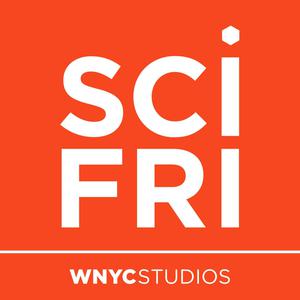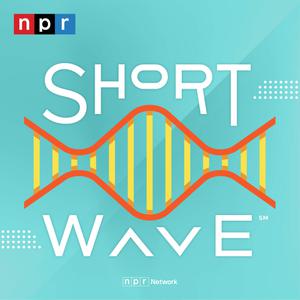
Science Friday
Science Friday and WNYC Studios
Brain fun for curious people.
- 25 minutes 28 secondsFlint’s Water Crisis, 10 Years Later | Underwater Cables Could Help Detect Tsunamis
While progress has been made in replacing water pipes in Flint, many residents say they still don’t know if their tap water is clean or not. Also, scientists are adding sensors to an underwater cable network to monitor changes in the ocean and quickly detect earthquakes and tsunamis.
10 Years Later, Flint’s Water Crisis Still Isn’t Over
In 2014, city officials in Flint, Michigan, switched their water source to the Flint River, a move that was projected to save the city $5 million. Instead, the water corroded the city’s lead pipes, which led to multiple negative health impacts for local residents, including lead poisoning, and a Legionnaires’ disease outbreak that resulted in a dozen deaths.
Now, almost 30,000 homes and businesses have had their water lines replaced, but 1,900 others have still not been reviewed. The city says they’ve reached out to owners of these properties with no response and have not been able to move forward, but activists claim that the city hasn’t contacted them.
Guest host Arielle Duhaime-Ross is joined by Vox senior correspondent Umair Irfan to talk about this and other top science news from this week, including new Long COVID trials that are underway, regulations from the EPA that require new coal and gas plants to limit 90% of their CO2 emissions, and a positive software update for Voyager 1.
How Underwater Telecom Cables Could Help Detect Tsunamis
Deep under the sea, a wide network of cables crisscrosses the ocean floor, keeping the internet and other telecommunications online. While these cables have a big job to do, researchers want to make them even more important by giving them the ability to detect seismic activity and alert those on land of a tsunami risk earlier than is currently possible.
Portugal is about to be the testing ground for these new, integrated cables, with a 3,700-kilometer cable to be installed between the Iberian country and the Madeira and Azores archipelagoes. This is a fitting place to pilot this, as Lisbon was the site of a devastating 1755 earthquake and tsunami that killed tens of thousands.
Joining guest host Arielle Duhaime-Ross to discuss the potential of smart cables is Dr. Bruce Howe, research professor of engineering at the University of Hawaii and chair of the United Nation’s SMART Cables Joint Task Force.
Transcripts for each segment will be available after the show airs on sciencefriday.com.
Subscribe to this podcast. Plus, to stay updated on all things science, sign up for Science Friday's newsletters.
26 April 2024, 8:00 pm - 19 minutes 2 secondsFighting Banana Blight | Do Birds Sing In Their Dreams?
America’s most-consumed fruit is at risk from a fungal disease. Researchers in North Carolina are on a mission to save Cavendish bananas. Also, birds move their vocal organs while they sleep, mimicking how they sing. Scientists have translated those movements into synthetic birdsong.
Fighting Banana Blight In A North Carolina Greenhouse
Bananas are the world’s most popular fruit. Americans eat nearly 27 pounds per person every year, according to the U.S. Department of Agriculture. A deadly fungus could destroy most of the world’s crops, but a company in Research Triangle Park is trying to save the banana through gene editing.
When it comes to growing bananas, RTP may not be the first place that pops in your head. But Matt DiLeo has a greenhouse full of them.
DiLeo is Vice President of Research and Development at Elo Life Systems, a biotechnology firm that’s exploring how gene editing can improve fruits and vegetables.
On a cloudy afternoon in early April, DiLeo opened the greenhouse door and stepped into a steamy atmosphere with a slightly floral odor. This greenhouse is packed floor to ceiling with banana trees. You’ve got to duck to keep the giant leaves from hitting your face. Some of the bananas are yellow, some are green, some are tiny and pink. DiLeo says they all share an important trait.
“Many of these are naturally resistant to the TR-4 fungus,” DiLeo said.
Read the rest of the article at sciencefriday.com.
Do Birds Sing In Their Dreams?
When birds sleep, what are they dreaming about? Researchers from the University of Buenos Aires have figured out a way to tap into bird dreams. When a bird slumbers, its voice box, called the syrinx, can move in ways that are similar to when they sing while they’re awake. Essentially, birds are silently singing in their dreams.
Now, researchers have figured out how to translate that vocal muscle movement into a synthetic bird song, meaning you can listen to how birds sing in their dreams.
Guest host Maggie Koerth talks with Dr. Gabriel Mindlin, professor of physics at the University of Buenos Aires about his latest bird dream research, published in the journal Chaos.
Transcripts for each segment will be available the week after the show airs on sciencefriday.com.
Subscribe to this podcast. Plus, to stay updated on all things science, sign up for Science Friday's newsletters.
25 April 2024, 8:00 pm - 17 minutes 53 secondsWhy Is Solving The Plastic Problem So Hard?
One of the biggest environmental issues in our modern world is plastic, which has become integral in the manufacturing of everything from electronics to furniture. Our reliance on plastic has led to a recycling crisis: A vast amount of plastic that winds up in our recycling bins isn’t actually recyclable, and ultimately winds up in landfills.
Large companies have committed to reducing plastic packaging and cutting back on waste. But there’s still no good way to scale up the removal of plastic that already exists. Waste-eating bacteria and enzymes have been shown to work in lab settings, but the scale-up process has a long road ahead.
Judith Enck, former EPA regional administrator and founder of the organization Beyond Plastics, has dedicated her career to advocating for making plastics more recyclable and keeping toxic chemicals out of the manufacturing process. She joins guest host Maggie Koerth to talk about why plastics are such a difficult environmental issue to solve, and what makes her feel hopeful this Earth Day.
Transcripts for this segment will be available the week after the show airs on sciencefriday.com.
Subscribe to this podcast. Plus, to stay updated on all things science, sign up for Science Friday's newsletters.
24 April 2024, 8:00 pm - 17 minutes 52 secondsWhat Worsening Floods Mean For Superfund Sites
Superfund sites are some of the most polluted areas in the country, containing highly toxic waste such as asbestos, lead, and dioxin. Cleaning them up, which follows a systematic, science-based process as required by law, can take decades.
There are more than 1,300 of these sites across the US, from Florida’s Panhandle to the banks of the Rio Grande in New Mexico. They’re found in nearly every state, often near residential areas. The EPA estimates that 78 million people live within three miles of a Superfund site—nearly 1 in 4 Americans.
But these waste dumps face a growing threat: the worsening effects of climate change. The EPA has determined that more than 300 Superfund sites are at risk of flooding. The actual number of flood-prone sites, however, may be more than twice that amount, according to a 2021 Government Accountability Office report. Floodwaters can move toxic waste into neighboring communities, which threatens drinking water, agriculture, and broader ecosystem health.
Read more at sciencefriday.com
Transcripts for each segment will be available after the show airs on sciencefriday.com.
Subscribe to this podcast. Plus, to stay updated on all things science, sign up for Science Friday's newsletters.
23 April 2024, 8:00 pm - 18 minutes 9 secondsThe Global Mental Health Toll Of Climate Change | Capturing DNA From 800 Lakes In One Day
An explosion of research is painting a clearer picture of how climate change is affecting mental health across the globe. Also, a citizen science project aims to find species that have gone unnoticed by sampling the waters of hundreds of lakes worldwide for environmental DNA.
Assessing The Global Mental Health Toll Of Climate Change
As the effects of climate change become more visible and widespread, people around the globe are dealing with the mental health impacts. But what are those impacts exactly, and how do they differ between people in different parts of the world? That’s been the focus of a rapidly growing area of research, which is seeking to understand the psychological impacts of climate change, sometimes referred to as “eco-anxiety.”
Guest host Maggie Koerth is joined by Dr. Alison Hwong, a psychiatry fellow at University of California San Francisco, to talk about what scientists have learned about global eco-anxiety and what strategies they’ve found to reduce its more harmful effects.
Citizen Scientists Will Capture DNA From 800 Lakes In One Day
Taking an accurate census of the organisms in an ecosystem is a challenging task—an observer’s eyes and ears can’t be everywhere. But a new project aims to harness the growing field of environmental DNA (eDNA) to detect species that might escape even the most intrepid ecologists. In the project, volunteers plan to take samples from some 800 lakes around the world on or around May 22, the International Day for Biological Diversity. Those samples will then be sent back to a lab in Zurich, Switzerland, where they’ll be analyzed for the tiny traces of DNA that organisms leave behind in the environment.
Dr. Kristy Deiner, organizer of the effort, hopes that just as lakes collect water from many streams across an area, they’ll also collect those eDNA traces—allowing researchers to paint a picture of the species living across a large area. She talks with SciFri’s John Dankosky about the project, and how this type of citizen science can aid the research community.
Transcripts for each segment will be available after the show airs on sciencefriday.com.
Subscribe to this podcast. Plus, to stay updated on all things science, sign up for Science Friday's newsletters.
22 April 2024, 8:00 pm - 25 minutes 12 secondsClean Energy Transition Progress | Avian Flu In Cattle And Humans Has Scientists Concerned
Global temperature increases are slowing, electric vehicle sales are growing, and renewable energy is now cheaper than some fossil fuels. Also, in a recent outbreak of avian flu, the virus has jumped from birds to cows, and to one dairy worker. A disease ecologist provides context.
Progress Toward A Clean Energy Transition
In honor of Earth Day, we’re highlighting a few positive trends and some promising solutions to the climate crisis. Globally, a clean energy transition is underway. A recent column in cipher, an online news outlet focused on climate solutions, recapped some encouraging progress, including a rise in electric car sales, a drop in the cost of renewable energy, and a slowing of global temperature increases.
SciFri’s John Dankosky is joined by Casey Crownhart, climate reporter at MIT Technology Review, to talk through some climate solutions news and other top science stories of the week, including a record year for wind energy, a proposal to swap out power lines to increase grid capacity, and hibernating bumble bees who can live for a week underwater.
Why Avian Flu In Cattle And Humans Has Scientists Concerned
During the last few weeks, you may have heard about an ongoing outbreak of avian flu in which the virus has jumped from wild birds and poultry to cattle in eight states, and now to one dairy worker. While transmission to cattle and humans is new, avian flu has been spreading and decimating wild bird populations for years, and has led to many farmers to “depopulate” their poultry stock to contain the spread of the deadly virus, with limited success.
Guest host Maggie Koerth is joined by Dr. Nichola Hill, assistant professor of biology at the University of Massachusetts Boston, to talk about how devastating this virus has been to birds across the world, why the jump from birds to mammals is making virologists anxious, and how concerned the rest of us should be.
Transcripts for each segment will be available the week after the show airs on sciencefriday.com.
Subscribe to this podcast. Plus, to stay updated on all things science, sign up for Science Friday's newsletters.
19 April 2024, 8:00 pm - 17 minutes 37 secondsA Cheer For The Physics Of Baseball
College basketball’s March Madness concluded this week, meaning that now the national sports attention can turn fully to baseball.
The next time you’re at the ballpark—whether you’re devoted enough to fill in the box scores by hand, or are just there for the peanuts and crackerjacks—take some time to appreciate the physics of the game. There are tricky trajectories, problems of parabolas, converging velocities, and the all-important impacts.
Dr. Frederic Bertley, the president and CEO of the Center of Science and Industry in Columbus, Ohio, joins Ira to talk about the science of sports, and about how sports can be a gateway to scientific literacy.
Transcripts for each segment will be available the week after the show airs on sciencefriday.com.
Subscribe to this podcast. Plus, to stay updated on all things science, sign up for Science Friday's newsletters.
18 April 2024, 8:00 pm - 18 minutes 51 secondsCarbon Cost Of Urban Gardens And Commercial Farms | Why There's No Superbloom This Year
Some food has a larger carbon footprint when grown in urban settings than on commercial farms, while for other foods the reverse is true. Also, what’s the difference between wildflowers blooming in the desert each spring, and the rare phenomenon of a “superbloom”?
The Carbon Cost Of Urban Gardens And Commercial Farms
If you have a home garden, you may be expecting that the food you grow has less of an environmental impact than food grown on large commercial farms. But new research throws some cold water on that idea. A study led by scientists at the University of Michigan examined 73 small urban gardening sites across the U.S., the U.K., France, Poland, and Germany, and found that food grown in urban settings produced six times more carbon emissions per serving than commercially grown food. The bulk of these emissions (63%) came from the building materials used for items like raised garden beds.
However, there are some foods that have a smaller carbon footprint when grown at home. They include crops like tomatoes and asparagus, which sometimes need to be flown long distances or require power-hungry greenhouses when grown commercially.
Jason Hawes, PhD candidate in the School for Environment and Sustainability at University of Michigan and lead author of the study which was published in Nature Cities, breaks down the results of the research with Ira. They talk about how urban farmers have responded to the findings, the positive social benefits of community gardens, and what home gardeners can do to lessen their carbon footprint.
Why There Won’t Be A Superbloom This Year
In California, wildflowers are in bloom.
Last year, there was a superbloom. Though there’s no official criteria, a superbloom is when there is an above average number of wildflowers blooming, mostly in desert regions of California and Arizona. It’s an explosion of color in regions that typically have sparse vegetation.
About a month ago, a few news articles hinted that maybe, just maybe, we were in for another superbloom year. Turns out we’re not.
Who decides when there’s a superbloom anyway? And why did this year turn out not to be a superbloom after all?
To answer those questions and provide an update on the state of California’s wildflowers, SciFri producer Kathleen Davis talks with Dr. Naomi Fraga, director of conservation programs at the California Botanic Garden, and research assistant professor at Claremont Graduate University.
Transcripts for each segment will be available after the show airs on sciencefriday.com.
Subscribe to this podcast. Plus, to stay updated on all things science, sign up for Science Friday's newsletters.
17 April 2024, 8:00 pm - 18 minutes 9 secondsInside The Race To Save Honeybees From Parasitic Mites
Last year, almost half of the honeybee colonies in the U.S. died, making it the second deadliest year for honeybees on record. The main culprit wasn’t climate change, starvation, or even pesticides, but a parasite: Varroa destructor.
“The name for this parasite is a very Transformer-y sounding name, but … these Varroa destructor mites have earned this name. It’s not melodramatic by any means. [They are] incredibly destructive organisms,” says Dr. Sammy Ramsey, entomologist at the University of Colorado Boulder.
These tiny mites feed on the bees and make them susceptible to other threats like diseases and pesticides. They’re also highly contagious: They arrived in the US in 1987, and now they live in almost every honeybee colony in the country. Honeybees pollinate many important crops, like apples, peaches, and berries, and their pollinator services add up to billions of dollars.
Ramsey and his lab are trying to put an end to the varroa mites’ spree. Part of their research includes spying on baby bees and their accompanying mites to learn how the parasites feed on the bees and whether there’s a way to disrupt that process.
In Boulder, Colorado, SciFri producer Rasha Aridi speaks with Dr. Ramsey and fellow entomologist Dr. Madison Sankovitz about how the varroa mites terrorize bees so effectively, and what it would take to get ahead of them.
Transcripts for each segment will be available the week after the show airs on sciencefriday.com.
Subscribe to this podcast. Plus, to stay updated on all things science, sign up for Science Friday's newsletters.
16 April 2024, 8:00 pm - 15 minutes 50 secondsThe Brain’s Glial Cells Might Be As Important As Neurons
Half of the cells in the brain are neurons, the other half are glial cells.
When scientists first discovered glia over a century ago, they thought that they simply held the neurons together. Their name derives from a Greek word that means glue.
In the past decade, researchers have come to understand that glial cells do so much more: They communicate with neurons and work closely with the immune system and might be critical in how we experience pain. They even play an important role in regulating the digestive tract.
Ira is joined by Yasemin Saplakoglu, a staff writer at Quanta Magazine who has reported on these lesser-known cells.
Transcripts for each segment will be available after the show airs on sciencefriday.com.
Subscribe to this podcast. Plus, to stay updated on all things science, sign up for Science Friday's newsletters.
15 April 2024, 7:59 pm - 25 minutes 43 secondsLimits On ‘Forever Chemicals’ In Drinking Water | An Important Winter Home For Bugs | Eclipse Drumroll
A long-awaited rule from the EPA limits the amounts of six PFAS chemicals allowed in public drinking water supplies. Also, some spiders, beetles, and centipedes spend winter under snow in a layer called the subnivium. Plus, a drumroll for the total solar eclipse.
EPA Sets Limits On ‘Forever Chemicals’ In Drinking Water
This week, the EPA finalized the first-ever national limits for the level of PFAS chemicals that are acceptable in drinking water supplies. Those so-called “forever chemicals,” per- and polyfluoroalkyl substances, have long been used in products like fire retardants and oil-and water-repellent coatings, and are now ubiquitous in the global environment. Water treatment plants will now have to test and treat for several varieties of the chemicals, which have been linked to a variety of health problems in people.
Sophie Bushwick, senior news editor at New Scientist, joins SciFri producer Kathleen Davis to talk about the rule and its potential impact on water agencies. They’ll also talk about other stories from the week in science, including research into a new vaccine against urinary tract infections, theories that extend the multiverse into a many-more-worlds interpretation, the passing of particle physicist Peter Higgs, and a new front in the war on pest rats: rodent contraceptives.
Where Snowpack Meets Soil: An Important Winter Home For Bugs
When winter rolls around and snow piles up, many insects head down to a small layer called the subnivium for the season.. This space, between snowpack and soil, shelters small insects, amphibians,and mammals from freezing temperatures.
Arthropods as a whole are understudied, says Chris Ziadeh, graduate of the University of New Hampshire and lead author of a recent study about the distinct communities that live in the subnivium. Better understanding which creatures call the subnivium home in the winter, as well as their behavior, could help us conserve them as the climate warms.
Guest host Kathleen Davis talks to Ziadeh about winter arthropod activity, species diversity, and why we should all care about protecting insects in our communities.
Drumroll Please! A Performance For The Solar Eclipse
People found all manner of ways to celebrate the solar eclipse that happened earlier this week, but one Science Friday listener found a particularly musical way to take in the experience.
Matt Kurtz, a sound artist and musician based in Akron, Ohio, realized his town would be in the path of totality for the April 8 eclipse. So with some funding from Akron Soul Train, a local artist residency, he put together a percussion section (complete with a gong) to perform a drumroll and build suspense up until the moment of totality. They performed in Chestnut Ridge Park to a crowd of onlookers.
“When you hear a [drumroll], it forces you to be like, something’s about to happen,” he said in an interview. “It’s a way to pay attention.”
As the gong rang out and the crowd cheered, Kurtz put down his sticks and experienced his first solar eclipse totality. “It was a release,” he said. “I had a couple minutes of peace where I got to look at the stars and feel where all this work went to.”
Transcripts for each segment will be available the week after the show airs on sciencefriday.com.
Subscribe to this podcast. Plus, to stay updated on all things science, sign up for Science Friday's newsletters.
12 April 2024, 8:00 pm - More Episodes? Get the App
Your feedback is valuable to us. Should you encounter any bugs, glitches, lack of functionality or other problems, please email us on [email protected] or join Moon.FM Telegram Group where you can talk directly to the dev team who are happy to answer any queries.
 Hidden Brain
Hidden Brain
 Science Magazine Podcast
Science Magazine Podcast
 Wait Wait... Don't Tell Me!
Wait Wait... Don't Tell Me!
 Short Wave
Short Wave
 Radiolab
Radiolab
 Big Picture Science
Big Picture Science